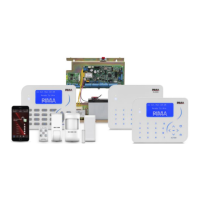12: Tests & Diagnostics
39 PIMA Electronic Systems
Appendix A. Implementing Partitions
FORCE allows defining up to 16 true partitions, whereby each can independently be in a
different arming mode, i.e., Away, Home, or Disarmed.
A partition is consist of several zones, and is normally a defined area, such as a building floor, a
store or a compartment. Every partition can have its own subscriber ID no., user codes,
keypads, peripherals, etc.
Partitions’ event reporting is subject to the following:
The ID no. of any partition that the zone is allocated to*.
If the zone is allocated to more than one partition, a separate report will
be sent on each partition.
If only partition’s #1 ID no. is defined, any event will carry that no.
The same as in zone alarm
The ID no. of any partition that the keypad is allocated to*.
* The event will be reported separately for each partition.
Zone, keypads, users, and contacts can be allocated to more than one partition. In such a case,
the following will apply:
1. Arming a zone is subject to all the partitions that the zone is allocated to: it will only be
armed when all its partitions are armed.
2. An armed zone becomes disarmed, as soon as one of the partitions it is allocated to is
disarmed.
3. Arming and disarming via a keypad is subject to both the keypad and the user’s
partitioning. For example, if a user that is allocated to partitions 1, 3 & 5, enters its code
in a keypad that is allocated to partitions 4, 5 & 7, only partition 5 will either be armed
or disarmed.
4. A keypad can only display the status of and control the partitions it’s allocated to. The
Armed
LED stays on only when ALL the keypad’s partitions are armed, and flashes when
only some partitions are armed.

